January Monthly Meeting
At the monthly ASNH meeting at Leitner Observatory, Al Washburn presented another batch of constellation posters made in years past by students in his astronomy classes. This month’s constellation was Draco, and there were some very artistic portrayals of the dragon.
The main speaker for the evening was Michael Miller, who presented a wealth of information about the history of the visual observation of Mars and observers’ attempts to draw what they saw. Mike began his account in the 1600s, when some of the first drawings of Mars were made by different observers, including Cassini, whose drawings included some rough surface markings. Later, in the 1870s, Giovanni Schiaparelli announced that he had observed “canali” on Mars, which is the Italian word for “channels.” But the American press translated the word as “canals”, which suggested structures made by intelligent beings.
Percival Lowell was very excited about this report, and he established Lowell Observatory in Flagstaff, Arizona, where he and his staff used a 24-inch Clark refractor to observe Mars. They claimed to see a complex network of canals across much of the surface of the planet.
In 1902, Walter Munder conducted an experiment called the “small boy experiment”, in which 12-14 year old boys were shown a drawing of a circle with sporadic marks and dots inside it. They viewed this drawing from a distance, and were told simply to “draw what you see.” Many of them drew pictures in which the the dots and marks were converted into lines. Munder’s point was that the canals on Mars were not real but rather due to a tendency of the human visual system to connect points into lines. However, this finding did not discourage Lowell or the others at Lowell Observatory, who continued to draw pictures of their canals, convinced that they were really there. Lowell wrote several popular books speculating about an advanced civilization on Mars, desperately using the canals to try to stay alive on a dry planet.
Miller also showed some curious drawings made by other observers that seemed to show networks of lines on other planets, including Venus and Jupiter!
It was not until the Mariner 9 spacecraft took close-up images of Mars in the 1970s that the theory of Martian canals was finally put to rest.
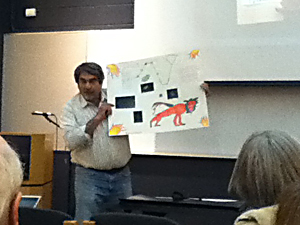
Al Washburn
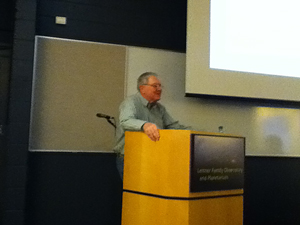
Michael Miller
Recent Outreach Activities
by Donna Pursley
North Branford Girl Scouts Outreach Event, March 5
Our first public outreach for the year was on Saturday March 5th at the Smith Library in Northford for the North Branford Girl Scouts. It was another one of those nights where it starts off all cloudy, so we think that there will be no viewing, and then magically, it is perfectly clear!
Al Washburn started with a presentation and showing the girls the meteorites. Then the 50 or so girls and parents came outside to look through our 7 scopes and binos. They were very interested and asked a lot of questions. The main attraction was Jupiter and its moons.
Our first event of 2016 turned out to be a success. Let’s hope it stays this way.
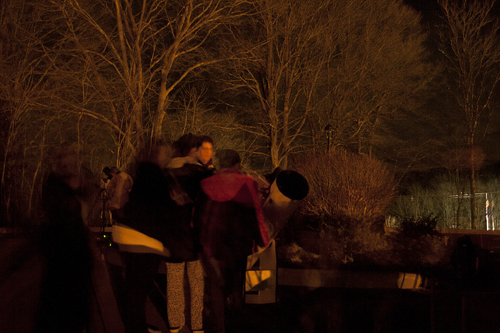
Greg Barker shows the Orion Nebula to girl scouts at the Smith Library in North Branford.
John B. Sliney Elementary School Science Fair, March 23
We were invited to bring our scopes to the John B. Sliney School in Branford for their science fair.
The event was early, starting at 6pm and only running till 8pm. Jim and Laurie were smart to bring a solar scope. Those that were outside were able to see features on the Sun until it set over a nearby building. Inside, Al Washburn presented our meteorite collection.
Then Jim brought out his scope and I had my scope. Jim was the first to find Jupiter rising.We focused on Jupiter until other stars started to pop out. I focused on Sirius and then later, the Orion Nebula.
There must have been at least 100 children and their adults. They all were very interested and glad that we were there. It turned out to be a good event even though it wasn’t that dark and a little cloudy.
Just after everyone left and we were getting ready to pack up, the sky around Jupiter became very clear, and several of us were able to see the shadows of THREE of Jupiter’s moons on its surface at once! That was an extra treat for the evening.
Public Viewing at Young’s Pond Park in Branford, March 26
We had our second event in Branford on Saturday, March 26th. We had lots of members with all kinds of scopes and binoculars. It was amazing! Thanks to all.
We had a small crowd, but they were very interested in everything that we were able to show them.
It was a mostly cloudy night with a few good holes through the clouds. We were able to show Jupiter and its moons, Sirius, a few nice doubles and, for a short time when there was a break in the clouds, the Orion Nebula. It sounded like everyone who came out had a good time and would be back at Young’s Park later in the year.
March Monthly Meeting
At the March meeting, Al Washburn presented posters of Ursa Major made by his high school students. Then, in our first segment of Astronomy 101, Bob Carruthers gave an informative presentation on “How the Sky Moves.” Bob’s presentation covered such topics as how much the Moon moves against the background stars in an hour and in a day; how much the constellations move in a week or in a month at the same time of night, and how the inner and outer planets trace their curving paths in the sky.
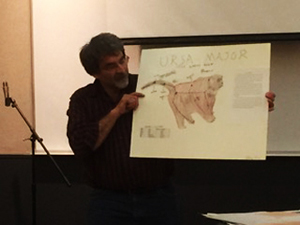
Al Washburn
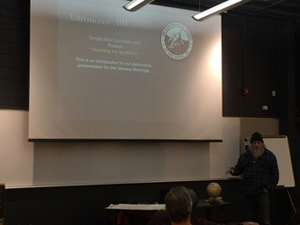
Bob Carruthers
